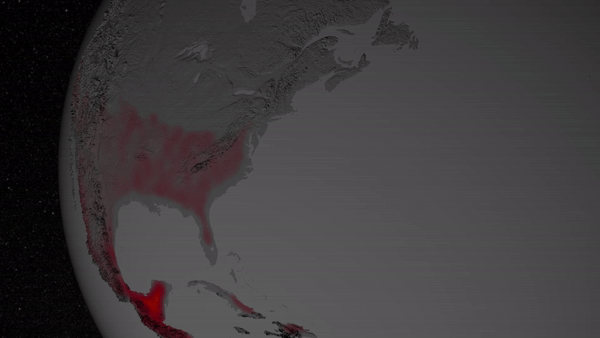Plants signal NASA satellites with waning 'glow' ahead of flash drought
A recent study allowed scientists to get clues months before the arrival of a dry spell.

Glowing plants?
Though that might sound like something out of a sci-fi movie, it's actually a natural process giving scientists clues of impending flash droughts.
Flash droughts are just what they sound like; they happen quickly and without much warning. An example of this occurred during the summer of 2012 when a large section of the U.S. experienced the most substantial flash drought it had seen since the Dust Bowl of the 1930s, which lasted for years.
Related: Scientists are mapping Earth's rivers from space before climate change devastates our planet
Typically, it takes seasons for a standard drought to develop — with a flash drought, however, expedited drying arises in just weeks. Thus, it's quite difficult to prepare for them. However, scientists at NASA's Jet Propulsion Laboratory in Southern California may have a solution. At the end of April, they released a study about their discovery of a way to recognize signs months in advance of a flash drought event. Signs from space, that is. You just have to look for the glow — or, well, lack thereof. It would appear that, in anticipation of a flash drought, the "glow" of a plant begins to dim, and it's possible to capture such dimming with spacecraft orbiting our planet.
More specifically, this glow is not visible to the human eye, but rather can be identified by certain instruments aboard satellites like NASA's Orbiting Carbon Observatory-2 (OCO-2). According to scientists, the plant glow phenomenon had been recurring on this satellite's data since 2014, when it arrived in space and began "seeing the light" across the Midwest U.S. throughout the growing season.
When plants go through photosynthesis, they bask in sunlight, absorbing our star's rays to transform water and carbon dioxide into food. During this process, some unused photons, or particles of light, escape from the plants' chlorophyll content, which refers to compounds which give plants their color. That produces a slight glow. This "glow" is called solar-induced fluorescence (SIF). The SIF grows brighter as a plant uses more carbon dioxide from the atmosphere to increase its growth.
Get the Space.com Newsletter
Breaking space news, the latest updates on rocket launches, skywatching events and more!
After looking at and comparing years of fluorescence data with flash droughts that happened across the U.S. between the months of May and July from 2015 to 2020, researchers were able to spot a glow-related pattern weeks (and sometimes even months) before a flash drought occurred. Using data from NASA's Soil Moisture Active Passive (SMAP) satellite, scientists were also able to note fluctuations in the amount of water in the plants' soil by observing the strength of natural microwave emissions released from the plants during this time period. Each year during the study, from May through July, the plants were, on average, flourishing from warm and dry conditions and thus glowing brightly on satellite imagery.
Then, as the water supply would begin to decrease ahead of a flash drought, the glow would start to fade. The variance in this atypical pattern closely matched with the amount of moisture losses soil six to 12 weeks in advance of a flash drought in different parts of the country.
"[Plant fluorescence] shows promise as a reliable early warning indicator of flash drought with enough lead time to take action," Nicholas Parazoo, an Earth scientist at JPL and lead author of the recent study, said in a statement.
Though this research may not be able to stop flash droughts from happening, it does offer forecasters a little more of a heads up so they can provide critical information to those who would be impacted by an upcoming drought.
"Farmers and ranchers with advanced operations can better use water for irrigation to reduce crop impacts, avoid planting crops that are likely to fail, or plant a different type of crop to achieve the most ideal yield if they have weeks to months of lead time," Jordan Gerth, a scientist with the National Weather Service Office of Observations, said in the same statement.
Another part of the study included learning more about how flash droughts have an effect on carbon emissions. During the photosynthesis process, plants and trees take in a lot more carbon dioxide than they give off, a crucial part of the carbon cycle which also includes interactions between the land, atmosphere and ocean. Carbon dioxide quantities can be obtained from OCO-2 satellite data — then, when scientists ingest that data into advanced computer models, they can determine how much carbon is absorbed by vegetation before and after a flash drought, the team says.
At the end of the day, when it comes to carbon absorption, the scientists concluded that a "balancing act" takes place during the time leading up to, and after, flash droughts. The more extreme the heat, the more the plants eat! Down the line, studies like this will likely help researchers enhance carbon cycle model predictions so we can better understand how plants operate and learn even more about how they are affected by extreme weather.
Join our Space Forums to keep talking space on the latest missions, night sky and more! And if you have a news tip, correction or comment, let us know at: community@space.com.

Meredith is a regional Murrow award-winning Certified Broadcast Meteorologist and science/space correspondent. She most recently was a Freelance Meteorologist for NY 1 in New York City & the 19 First Alert Weather Team in Cleveland. A self-described "Rocket Girl," Meredith's personal and professional work has drawn recognition over the last decade, including the inaugural Valparaiso University Alumni Association First Decade Achievement Award, two special reports in News 12's Climate Special "Saving Our Shores" that won a Regional Edward R. Murrow Award, multiple Fair Media Council Folio & Press Club of Long Island awards for meteorology & reporting, and a Long Island Business News & NYC TV Week "40 Under 40" Award.









